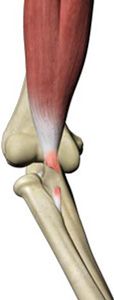Biceps Tendon Rupture

What is the Biceps Tendon?
Your biceps muscle is attached to the shoulder joint through tendons forming two heads, a long head and short head.
Causes of Biceps Tendon Rupture
Overuse and injury of the biceps muscle during weightlifting or any repetitive physical activity causes fraying and eventual long head biceps tendon rupture. It can also occur due to falling on an outstretched arm.
Risks Factors for Biceps Tendon Rupture
The risk factors for long head biceps tendon rupture include:
- Old age
- Repetitive overhead activities
- Smoking
- Corticosteroid medication use
Types of Biceps Tendon Rupture
Tears of the biceps tendon may be either:
- Partial tears
- Complete tears
Symptoms of Biceps Tendon Tear
The symptoms that may occur with biceps tendon rupture include:
- A popping sound
- A snapping sensation
- Pain with overhead activity
- Weakness in the shoulder
- Bruising in the upper arm
Diagnosis of Biceps Tendon Tear
Your doctor diagnoses a biceps tendon rupture after observing your symptoms and taking a medical history. A physical exam is performed where your arm is moved in different directions in order to see which movements elicit pain or weakness. Imaging studies such as X-rays may be ordered to assess for bony deformities such as spurs, which may have caused the tear. An MRI scan can help determine if the tear is partial or complete.
Treatment of Biceps Tendon Tear
Nonsurgical treatment includes:
Rest: A sling is used to rest the shoulder and you are advised to avoid overhead activities and heavy lifting until healed.
Ice: Applying ice packs for 20 minutes at a time, 3 to 4 times a day, helps reduce swelling.
Medications: Non-steroidal anti-inflammatory medicines help reduce pain and swelling.
Physical therapy: Strengthening and flexibility exercises help restore strength and mobility to the shoulder joint.
Surgery
Surgery may be necessary if your symptoms are not relieved by conservative measures and if you are an athlete and require full restoration of strength. Your surgeon makes an incision near your shoulder where the tendon is torn. The torn end of the tendon is cleaned, and the bone is prepared by creating drill holes. Sutures are woven through the holes, and the tendon to secure it back to the bone and hold it in place. The incision is then closed and a dressing applied.
